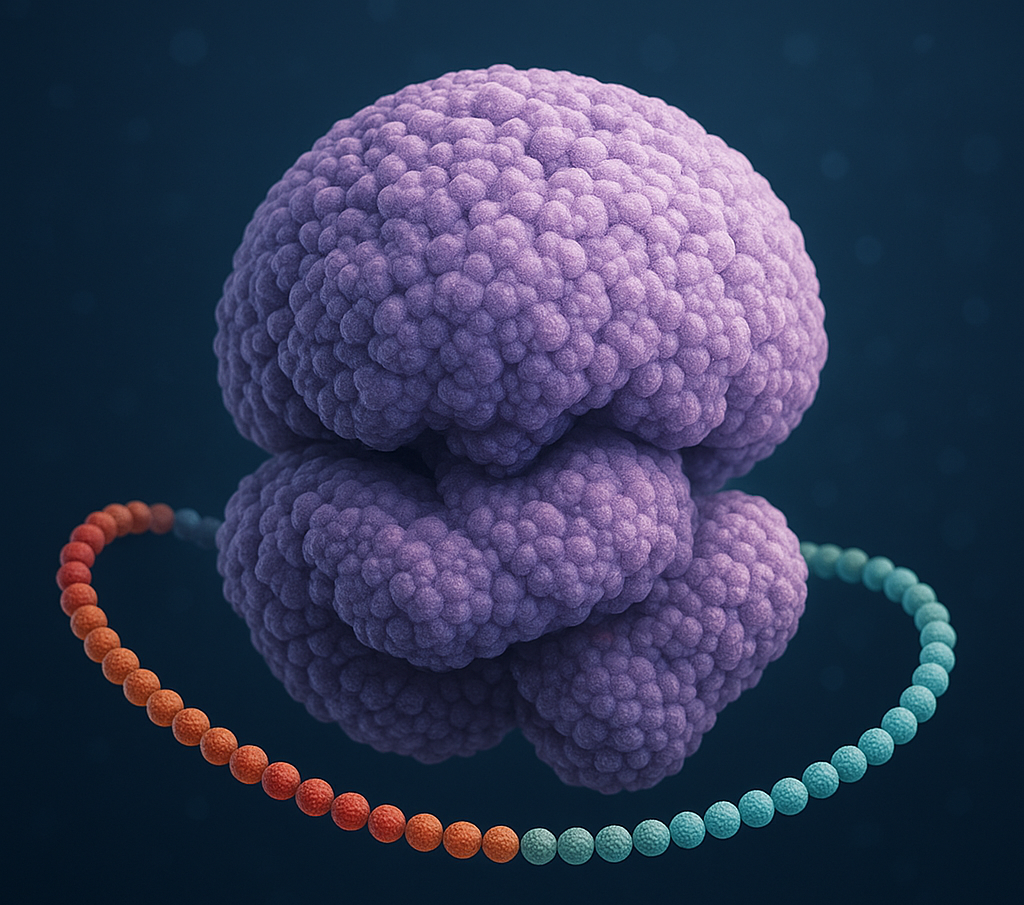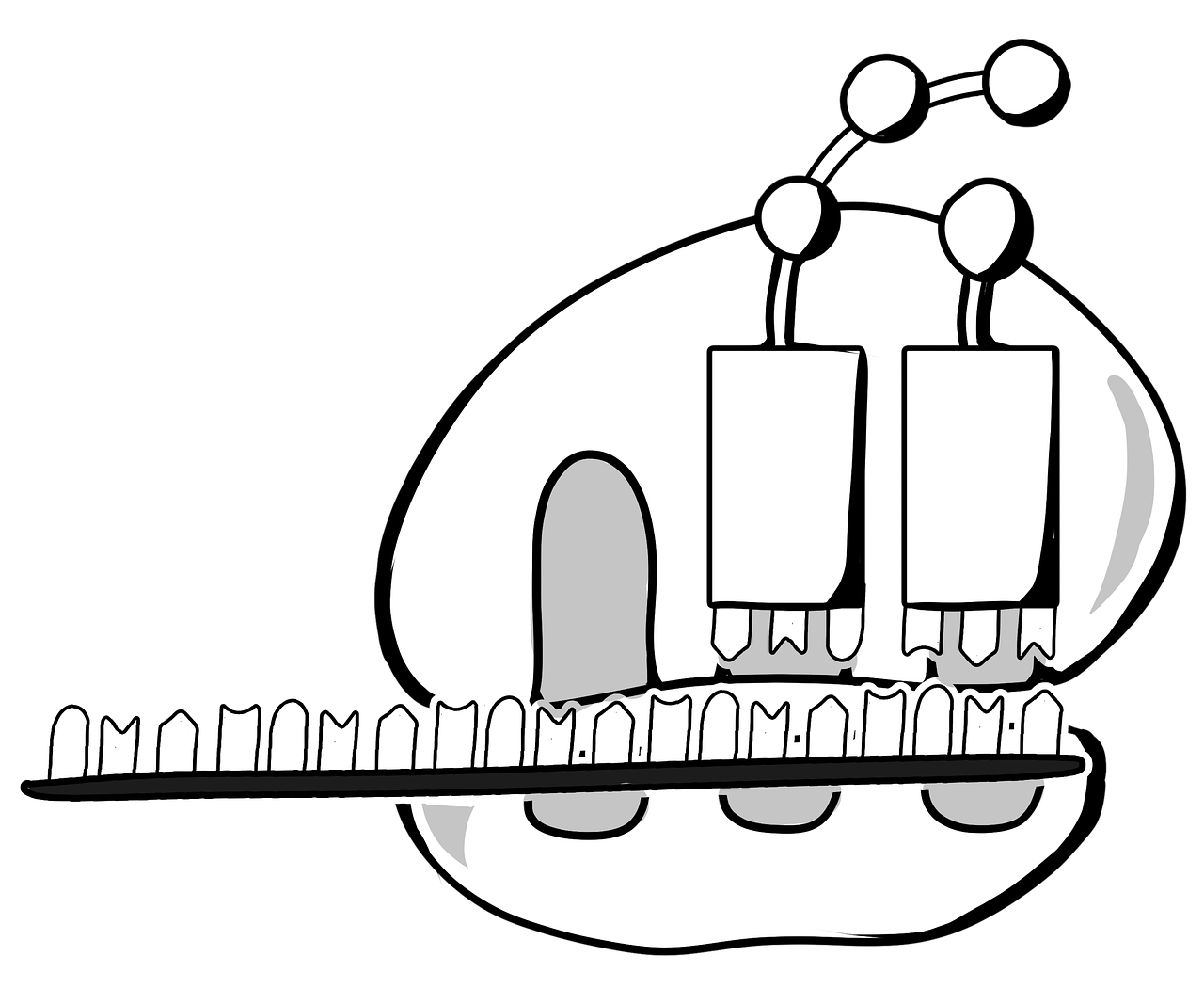Ribosomes are fundamental organelles found in all cells and are responsible for protein synthesis. Present in both prokaryotic and eukaryotic cells, they play a critical role in the process of translating genetic information into proteins. Ribosomes exhibit structural and functional differences depending on the cell type, and they are localized in specific regions within the cell. Moreover, they display structural diversity across different species.

Ribosome Organelle (Generated by Artificial Intelligence)
Definition and Structure
The ribosome is a cellular structure found in all living cells and is responsible for protein synthesis. While present in both prokaryotes and eukaryotes, ribosomes exhibit certain structural and functional differences. They are ribonucleoprotein complexes composed of ribonucleic acid (RNA) and proteins. Prokaryotic ribosomes are 70S in size (Svedberg unit), whereas eukaryotic ribosomes are larger and more complex, with a size of 80S. In eukaryotic cells, ribosomes are generally found freely in the cytoplasm, though some are attached to the endoplasmic reticulum (ER), particularly the rough ER. In prokaryotic cells, ribosomes are found freely distributed in the cytoplasm.
Ribosomal Subunits
Ribosomes consist of two main subunits: a large subunit and a small subunit. In prokaryotic ribosomes, the small subunit is referred to as 30S and the large subunit as 50S. In contrast, eukaryotic ribosomes comprise a 40S small subunit and a 60S large subunit. These subunits maintain the structural integrity of the ribosome and play a crucial role in ensuring the accurate reading of mRNA and the correct sequential addition of amino acids during translation.
Structural Features of Ribosomes
The structural characteristics of ribosomes are optimized to perform the functions required for protein synthesis. Ribosomes are complex structures formed by the assembly of small and large subunits, which themselves consist of rRNA and associated proteins. Active sites within the ribosome facilitate the reading of mRNA and the incorporation of amino acids. These functional centers are essential for the construction of the polypeptide chain and are critical to the ribosome’s operational capabilities. Additionally, various surrounding structures help ensure that mRNA is read accurately.
Functions
The primary function of ribosomes is to synthesize proteins by decoding the genetic information carried by messenger RNA (mRNA). This process, known as translation, involves reading the codons (triplet nucleotide sequences) on the mRNA and matching them with the appropriate amino acids delivered by transfer RNA (tRNA), forming peptide bonds in the process. Ribosomes use mRNA as a template to build polypeptide chains in a sequential manner.
Role of Ribosomes in the Cell
Ribosomes are central to protein synthesis in the cell. Protein production is vital for cell growth, repair, metabolism, and overall functionality. Ribosomes may exist freely in the cytoplasm or be bound to the endoplasmic reticulum. Those located on the rough ER are especially involved in synthesizing proteins destined for secretion or integration into the cell membrane. The number and distribution of ribosomes within the cell may vary depending on the cell’s structural and energetic demands. During cell division, ribosomes become active in producing specific proteins, making them essential organelles that ensure the continuity of cellular functions.

Illustrative Image of Protein Synthesis by the Ribosome Organelle (Pixabay)
Ribosomes and Genetic Control
Ribosomes are responsible for the accurate expression of genetic information, which is crucial for cellular functions. Messenger RNA (mRNA) is translated by the ribosome into proteins based on the genetic instructions encoded in DNA. This process is regulated by genetic control mechanisms at the cellular level. These regulatory systems ensure that ribosomes function properly, as errors in protein synthesis can disrupt essential cellular processes. Ribosomes are vital for the precise transmission of genetic information and the correct assembly of proteins. Additionally, they play an important role during cellular stress. Under such conditions, ribosomes can modulate protein synthesis under genetic regulation to adapt to environmental or physiological changes.
Intracellular Localization and Distribution of Ribosomes
Ribosomes are the primary organelles responsible for protein synthesis and are found in various locations within cells. In prokaryotic cells, ribosomes are freely distributed throughout the cytoplasm. In eukaryotic cells, ribosomes exist both freely in the cytoplasm and attached to the endoplasmic reticulum (ER). Those bound to the ER form what is known as the rough ER and are primarily involved in synthesizing proteins destined for secretion or membrane integration. Ribosomes are also present in energy-producing organelles such as mitochondria and chloroplasts. The presence of their own ribosomes in these organelles reflects their evolutionary origins.Ribosomes are generally present in high abundance within cells due to the critical importance of protein synthesis. While free ribosomes are predominantly located in the cytoplasm, those attached to the rough ER synthesize proteins that are either secreted from the cell or incorporated into cellular membranes. The distribution of ribosomes varies according to the cell type, its function, and its metabolic demands. For example, cells with high metabolic activity may contain an increased number of ribosomes to support elevated protein production. Additionally, during cell division, ribosomes may relocate within the cell to prioritize the synthesis of specific proteins.
Although ribosomes perform a conserved function across all forms of life, their structures vary significantly among different organisms. The differences between prokaryotic and eukaryotic ribosomes include disparities in size, subunit composition, and the specific structural proteins involved.
Prokaryotic Ribosomes
Ribosomes in prokaryotes are generally smaller and structurally simpler. These ribosomes are 70S in size, consisting of a 30S small subunit and a 50S large subunit. They contain fewer and less complex proteins and RNA sequences suited to the needs of bacterial cells. Prokaryotic ribosomes are common targets of antibiotics, many of which function by inhibiting bacterial protein synthesis.
Eukaryotic Ribosomes
Eukaryotic ribosomes are larger and more complex, with a size of 80S, composed of a 40S small subunit and a 60S large subunit. These ribosomes possess greater structural diversity and contain more intricate proteins. In addition to their presence in the cytoplasm and on the ER, eukaryotic ribosomes are also found within organelles such as mitochondria and chloroplasts. The ribosomes in these organelles resemble prokaryotic ribosomes, providing strong evidence for the theory that mitochondria and chloroplasts originated from ancestral prokaryotic cells.
Archaeal Ribosomes
Although archaeal ribosomes are structurally similar to those of prokaryotes, they also share certain features with eukaryotic ribosomes. Archaeal ribosomes are slightly larger than bacterial ones and exhibit genetic and structural characteristics more closely related to those of eukaryotes. These features suggest that archaeal ribosomes possess a unique and evolutionarily complex architecture.


